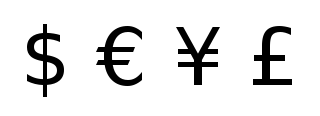Related Research Articles

Unicode, formally the Unicode Standard, is an information technology standard for the consistent encoding, representation, and handling of text expressed in most of the world's writing systems. The standard, which is maintained by the Unicode Consortium, defines 144,697 characters covering 159 modern and historic scripts, as well as symbols, emoji, and non-visual control and formatting codes.

A currency symbol or currency sign is a graphic symbol used as a shorthand for a currency's name, especially in reference to amounts of money.
In Unicode, a Private Use Area (PUA) is a range of code points that, by definition, will not be assigned characters by the Unicode Consortium. Three private use areas are defined: one in the Basic Multilingual Plane, and one each in, and nearly covering, planes 15 and 16. The code points in these areas cannot be considered as standardized characters in Unicode itself. They are intentionally left undefined so that third parties may define their own characters without conflicting with Unicode Consortium assignments. Under the Unicode Stability Policy, the Private Use Areas will remain allocated for that purpose in all future Unicode versions.
Geometric Shapes is a Unicode block of 96 symbols at code point range U+25A0–25FF.
In computing, a Unicode symbol is a Unicode character which is not part of a script used to write a natural language, but is nonetheless available for use as part of a text.
Many scripts in Unicode, including Arabic and Devanāgarī, have special orthographic rules that require certain combinations of letterforms to be combined into special ligature forms.
In the Unicode standard, a plane is a continuous group of 65,536 (216) code points. There are 17 planes, identified by the numbers 0 to 16, which corresponds with the possible values 00–1016 of the first two positions in six position hexadecimal format (U+hhhhhh). Plane 0 is the Basic Multilingual Plane (BMP), which contains most commonly used characters. The higher planes 1 through 16 are called "supplementary planes". The last code point in Unicode is the last code point in plane 16, U+10FFFF. As of Unicode version 13.0, seven of the planes have assigned code points (characters), and five are named.
The Unicode Standard assigns various properties to each Unicode character and code point.
Enclosed CJK Letters and Months is a Unicode block containing circled and parenthesized Katakana, Hangul, and CJK ideographs. Also included in the block are miscellaneous glyphs that would more likely fit in CJK Compatibility or Enclosed Alphanumerics: a few unit abbreviations, circled numbers from 21 to 50, and circled multiples of 10 from 10 to 80 enclosed in black squares.
Indic Siyaq Numbers is a Unicode block containing a specialized subset of the Arabic script that was used for accounting in India under the Mughals by the 17th century through the middle of the 20th century.
Egyptian Hieroglyph Format Controls is a Unicode block containing formatting characters that enable full formatting of quadrats for Egyptian hieroglyphs.
Elymaic is a Unicode block containing characters for the Elymaic alphabet, used in the ancient state of Elymais.
Nandinagari is a Unicode block containing characters for Nandinagari script, historically used to write Sanskrit in southern India.
Nyiakeng Puachue Hmong is a Unicode block containing characters devised in the 1980s for writing the White Hmong and Green Hmong languages.
Tamil Supplement is a Unicode block containing Tamil historic fractions and symbols.
Wancho is a Unicode block containing the characters of the script used to write the Wancho language.
Symbols and Pictographs Extended-A is a Unicode block containing emoji characters. It extends the set of symbols included in the Supplemental Symbols and Pictographs block.
Small Kana Extension is a Unicode block containing additional small variants for the Hiragana and Katakana syllabaries, in addition to those in the Hiragana, Katakana and Katakana Phonetic Extensions blocks.

The Dogri script is a writing system originally used for writing the Dogri language in Jammu and Kashmir in the northern part of the Indian subcontinent. The Takri script version of Jammu is known as Dogra Akkhar
References
- ↑ "Unicode character database". The Unicode Standard. Retrieved 2019-03-05.
- ↑ "Enumerated Versions of The Unicode Standard". The Unicode Standard. Retrieved 2019-03-05.
- ↑ "Chapter 22: Symbols". The Unicode Standard, Version 12.0 (PDF). Mountain View, CA: Unicode, Inc. March 2019. ISBN 978-1-936213-22-1.